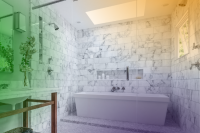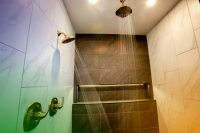Although most of us would prefer to get a professional plumber in to install a new shower, it’s possible to save a bit of cash by doing some of the related jobs yourself, increasing the budget for your new shower, or allowing you to splash out elsewhere in the bathroom.
Fitting the shower tray for your new shower is a job which can be done with only a minimum of DIY knowledge, so here’s what you need to do if you are taking on this job by yourself.
Fitting a shower tray should be fairly straightforward but if you're not skilled at DIY, you can always look up a professional bathroom tradesman and ask for a quote.
Choosing the right shower enclosure
Shower trays and enclosures come in all shapes and sizes, so the first step should be measuring the space you have in your bathroom and deciding which sort of tray is most appropriate.
There is no “best” type of shower enclosure – the decision will be based on the size of your room and the configuration.
Measure your bathroom before going shopping and draw a simple floor plan, as when you’re in a cavernous bathroom showroom or DIY superstore it can be hard to keep a sense of perspective and imagine an item in your room.
Acrylic shower trays are the easiest to install, and are light manageable.
Installing a stone shower tray requires additional skills and is probably best left to the plumbing professionals.
These types of shower trays can be quite expensive compared with the standard run of the mill products so there is little room for error when undertaking a DIY task on stone shower trays.
If you’re installing a new shower, you’ll need to call a professional bathroom fitter to handle the plumbing.
Preparing to Fit Your New Shower Tray
Start by unpacking your shower tray or enclosure and check that all the parts are there, and that it’s in good condition.
This is particularly important if you’ve ordered online as items can be damaged in transit and if you do need to return the product you'll want to make sure you notice any issues with the quality of the product on delivery.
If you're taking receipt of a shower tray or indeed any other products from couriers it's worth making a note when you sign for the product which states you have not examined the item when you receive it.
Simply write "unexamined" when you sign for the delivery and this will indicate that whilst you've received the item you haven't at this point checked for whether it has been damaged or not.
After you've checked everything to make sure your products are in good condition when received you're ready to proceed onto the next steps.
Turn off water at the mains and get the tools you’ll need for the job. Most acrylic shower trays come with a riser kit, designed to lift the tray off the floor and to let the water drain away. Read through any instructions which came with the tray, and make sure you know roughly what you’re doing.
If you’re not sure how to fit a shower tray, follow our simple rules. You’ll need the following tools to install a shower tray:
Tools needed to fit a shower tray
- Spirit level
- Tape measure
- Pencil
- Jigsaw
- Cordless drill/driver
- Pointing or gauging trowel
- Bucket
How to Fit the Shower Tray
Start by screwing the adjustable feet onto the bottom of the tray using the manufacturer’s instructions, then fit the waste pipe into the base of the shower tray. Place the shower tray into its position in the bathroom, but don’t attach it yet – use your spirit level to make sure it is straight and level, and adjust the feet where necessary. Once you are happy with the level of the tray, connect up the waste coming from the base of the shower tray into the existing waste water pipe. Make sure that everything is tightened and very secure – you don’t want any leaking water soaking into your bathroom floor. Clip on the side panels provided for a professional finish for your tray, and switch the water back on. Check again carefully for leaks, and if you are happy that everything is watertight, go ahead and seal along the join between the shower tray and the floor using silicone sealant. Leave everything to dry overnight before fitting the doors to your shower enclosure.
Step by step instructions
- Place your shower tray in the spot where you want to install it.
- Mark the spot by drawing around the tray with a pencil.
- Decide where the draining pipes will go and cut a space in the hardboard floor to make room for them.
- Cut an access hatch next to the tray too, so you’ve got access to the pipes - make sure you can comfortably reach your arm inside it to access the pipes.
- Screw pieces of batten under the edges of the hole to support the flooring.
- Now attach the waste outlet to the shower tray.
- It should come with manufacturer’s instructions, so make sure you follow them carefully.
- Double-check that the waste outlet is water-tight with washers or gaskets fitted on each side of the waste opening.
- Mix a diluted PVA solution using one part water to five parts PVA.
- Spread it in the spot where you’re going to fit the tray and leave it to dry.
- Now, get a bucket and mix some mortar. You’ll need four parts building sand to one part cement.
- Mix it until the consistency is firm, then spread a thin layer in the spot where you’re going to install the shower tray.
- You're now ready to slot the tray into position.
- Allow it to bed into the mortar, remembering to use a spirit level to make sure it's level.
- If it isn't, you may have to remove the tray and adjust the mortar. When you're done, leave the mortar to dry for about 24 hours.
- Finally, you’re ready to connect the trap to the waste outlet and join it to the waste outlet pipe.
- Be sure to check for leaks and if you find any, seal it using a sealant gun.
If DIY’s not really your thing, you might want to call a local bathroom specialist.
A good bathroom tradesman will do a professional job in no time at all!
Alternatively, you can use Top Tradespeople's free tradesmen quotes services to find and compare local bathroom fitters quotes.
Disclaimer: All Top Tradespeople 'How To Guides' are for reference only.
You should always seek expert advice when carrying out any home improvement or property refurbishments to your home.
Remember:
If you need to compare from any types of local tradesmen, you can normally use our free quotes comparison service to find a tradesman near you.







